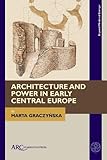Architecture and Power in Early Central Europe / Marta Graczynska.
Material type: TextSeries: Beyond Medieval EuropePublisher: Leeds : ARC Humanities Press, [2022]Copyright date: ©2022Description: 1 online resource (144 p.)Content type:
TextSeries: Beyond Medieval EuropePublisher: Leeds : ARC Humanities Press, [2022]Copyright date: ©2022Description: 1 online resource (144 p.)Content type: - 9781802700145
- 723-724
- online - DeGruyter
| Item type | Current library | Call number | URL | Status | Notes | Barcode | |
|---|---|---|---|---|---|---|---|
 eBook
eBook
|
Biblioteca "Angelicum" Pont. Univ. S.Tommaso d'Aquino Nuvola online | online - DeGruyter (Browse shelf(Opens below)) | Online access | Not for loan (Accesso limitato) | Accesso per gli utenti autorizzati / Access for authorized users | (dgr)9781802700145 |
Frontmatter -- CONTENTS -- LIST OF ILLUSTRATIONS -- INTRODUCTION -- Chapter 1 DISPLAYS OF POWER— ARCHITECTURE AS SIGN AND SYMBOL -- Chapter 2 CHOICE OF ARCHITECTURAL FORMS -- Chapter 3 THE CODE OF FORM AND SHAPE -- Chapter 4 COMPOSITION OF SPATIAL ARRANGEMENTS -- Chapter 5 APPROPRIATION AND/OR INFLUENCE -- Chapter 6 ARCHITECTURE AS A VEHICLE OF MEANINGS -- Chapter 7 FORM VERSUS FUNCTION -- Chapter 8 INTERPRETING FUNCTION -- Chapter 9 READING ARCHITECTURE -- CONCLUSION -- SELECT BIBLIOGRAPHY -- INDEX
restricted access online access with authorization star
http://purl.org/coar/access_right/c_16ec
The book presents the panorama of social, cultural, and religious changes in the states of the Piast, Přemyslid, and Arpad dynasties. Major change occurred in the tenth century and again at the turn of the eleventh century. Given the scarcity of written sources, the author employs an analysis of architectural forms which she applies to buildings founded by dukes, kings, and nobles at this period. Architecture serves as a reliable source of knowledge and can be successfully read as a text using comparative analysis, iconology, and semiotics. No piece of art appeared without an historical context: forms, functions, and styles are all documents created by its founders and creators. The conclusions of this research help us to understand the era that shaped the foundations of the Polish, Czech, and the Hungarian states.
Mode of access: Internet via World Wide Web.
In English.
Description based on online resource; title from PDF title page (publisher's Web site, viewed 27. Jan 2023)


